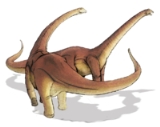
Alamosaurus
Overview
Genus
In biology, a genus is a low-level taxonomic rank used in the biological classification of living and fossil organisms, which is an example of definition by genus and differentia...
of titanosaurian sauropod dinosaur
Dinosaur
Dinosaurs are a diverse group of animals of the clade and superorder Dinosauria. They were the dominant terrestrial vertebrates for over 160 million years, from the late Triassic period until the end of the Cretaceous , when the Cretaceous–Paleogene extinction event led to the extinction of...
from the Late Cretaceous
Cretaceous
The Cretaceous , derived from the Latin "creta" , usually abbreviated K for its German translation Kreide , is a geologic period and system from circa to million years ago. In the geologic timescale, the Cretaceous follows the Jurassic period and is followed by the Paleogene period of the...
Period of what is now North America
North America
North America is a continent wholly within the Northern Hemisphere and almost wholly within the Western Hemisphere. It is also considered a northern subcontinent of the Americas...
. It was a large quadruped
Quadruped
Quadrupedalism is a form of land animal locomotion using four limbs or legs. An animal or machine that usually moves in a quadrupedal manner is known as a quadruped, meaning "four feet"...
al herbivore
Herbivore
Herbivores are organisms that are anatomically and physiologically adapted to eat plant-based foods. Herbivory is a form of consumption in which an organism principally eats autotrophs such as plants, algae and photosynthesizing bacteria. More generally, organisms that feed on autotrophs in...
. Isolated vertebrae and limb bones indicate that it reached sizes comparable to Argentinosaurus
Argentinosaurus
Argentinosaurus is a genus of titanosaur sauropod dinosaur first discovered by Guillermo Heredia in Argentina. The generic name refers to the country in which it was discovered...
and Puertasaurus
Puertasaurus
Puertasaurus is a genus of titanosaurid sauropod that appeared during the Late Cretaceous. It lived in what is now Patagonia. The type species, Puertasaurus reuili, is named in honor of Pablo Puerta and Santiago Reuil, the co-discoverers in January 2001 of the specimen...
, which would make it the largest dinosaur known from North America. Alamosaurus, like other sauropods, had a long neck and a long tail.
Contrary to popular assertions, this dinosaur is not named after the Alamo
Alamo Mission in San Antonio
The Alamo, originally known as Mission San Antonio de Valero, is a former Roman Catholic mission and fortress compound, site of the Battle of the Alamo in 1836, and now a museum, in San Antonio, Texas....
in San Antonio, Texas
Texas
Texas is the second largest U.S. state by both area and population, and the largest state by area in the contiguous United States.The name, based on the Caddo word "Tejas" meaning "friends" or "allies", was applied by the Spanish to the Caddo themselves and to the region of their settlement in...
, or the battle
Battle of the Alamo
The Battle of the Alamo was a pivotal event in the Texas Revolution. Following a 13-day siege, Mexican troops under President General Antonio López de Santa Anna launched an assault on the Alamo Mission near San Antonio de Béxar . All but two of the Texian defenders were killed...
that was fought there.
Unanswered Questions

